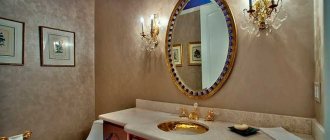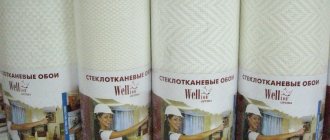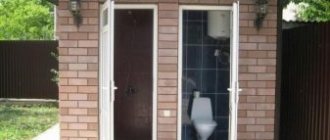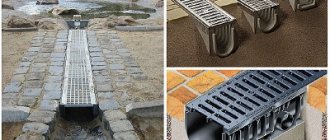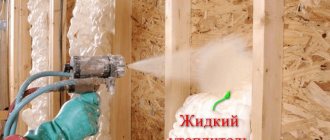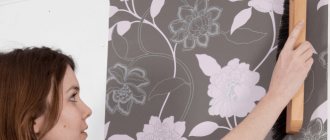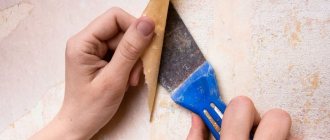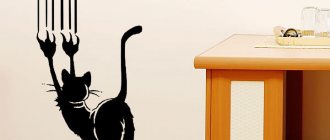Crushed natural stone has earned the recognition of landscape designers due to the fact that it amazingly combines all the advantages of natural stones with a wide range of possible uses.
Small pieces of stones, sorted by fraction size, exactly replicate the color of the natural mineral and give a lot of scope for imagination.
Steps made of decorative stone chips
In addition, decorative chips for landscape design can be subjected to additional processing - sanding, painting, which further expands the possibilities when designing a site. This is a relatively inexpensive material. It does not require additional equipment or special work on the formation of foundations. All this makes the idea of using decorative stone chips a favorite among landscapers.
Decorative chips in landscape design
Liquid wallpaper. What it is?
Surely, you have already heard about a fairly new finishing material for walls and ceilings, liquid wallpaper. Let's find out with you what it is? Liquid wallpaper is a mixture of filler, glue, dye and some additives. Various decorative additives can be added to the mixture: sparkles, marble or mica chips, etc. The filler can be silk or cellulose (for example, plain paper). Manufacturers usually add substances that prevent the formation of fungus and mold. As well as various additives that give the mixture of liquid wallpaper plasticity (for example, ordinary gypsum). As a result, we get a finishing material that is something between decorative plaster and ordinary wallpaper. If you are wondering which filler for liquid wallpaper is better, silk or cellulose, let's take a closer look at these types of liquid wallpaper.
What substances are used for production?
To create this version of the finishing material, the following components are used:
- Adhesive base. This material is made in the form of a dry powder, which after contact with water increases in size and promotes adhesion of the decor to the concrete plane;
- Dyes. They allow you to paint the working composition in the required shade;
- Pulp of different sizes. For the production of liquid wallpaper, paper of different compositions and strengths is used. It is she who sets the texture and volume on the surface of the wall;
- Small fibers of silk threads. They provide the finished surface with shine and silky texture;
- Antiseptics and fungicides. These substances prevent the growth of bacteria and fungi on the surface;
- Decorative details in the form of mica, mother-of-pearl chips, sparkles of different diameters and mineral chips.
The material for decorating the interior space is sold in the form of a dry powder, which is pre-packaged in containers of different diameters. The shelf life of such finishing material is from 10 to 15 years.
Types of liquid wallpaper
Silk liquid wallpaper is so called because its filler is silk. Which is very logical.)) The undoubted advantage of silk liquid wallpaper will be its durability and beauty. They do not fade in the sun, unlike cellulose liquid wallpaper. But the cost of such wallpaper is quite high. However, silk liquid wallpaper can be made independently and in this case its cost will be much lower. But more on that a little later.
Cellulose liquid wallpaper contains one type of cellulose. Mainly paper is used. That is why cellulose liquid wallpaper is most often called liquid paper wallpaper. This material is not as good as silk, but it is very cheap and making liquid wallpaper from paper with your own hands will not be difficult for you.
Another filler can be wood shavings or sawdust. Liquid wallpaper made from this material is very original and quite durable.
But most often, in the decoration of premises they use a mixed type of liquid wallpaper: cellulose-silk. It combines the useful and practical qualities of both materials, and its cost is affordable.
What do liquid wallpapers look like? You can see photos of different types of liquid wallpaper below.
Liquid wallpaper pros and cons
As usual, let's talk about the bad first. The disadvantages of liquid wallpaper are few, but you need to know them.
Liquid wallpaper cons:
- Price. High-quality silk liquid wallpaper is quite expensive. However, paper liquid wallpaper made independently is practically free.
- Liquid wallpaper is afraid of water. It is not advisable to use them in bathrooms and kitchens. Even if you cover liquid wallpaper with varnish, there is no guarantee that it will adhere firmly to the wall or ceiling. Liquid wallpaper swells from water and moisture and is easily removed from the surface.
That's all the shortcomings. Now for the good stuff. After all, liquid wallpaper has undeniable advantages.
Liquid wallpaper pros:
- Environmental friendliness. If you carefully read the composition of liquid wallpaper, you will see that the materials used are absolutely harmless to the human body. Liquid wallpaper can be used in children's rooms without fear for the health of children.
- Antistatic. Liquid wallpaper does not accumulate static electricity.
- Hypoallergenic.
- They repel and do not accumulate dust.
- Hides minor imperfections of the surface on which they are applied. Hence the ease of preparing the surface for applying liquid wallpaper.
- Self-application. You can apply liquid wallpaper with your own hands, even alone, without helpers. Gluing liquid wallpaper is a quick and easy process.
- Seamless finish. Liquid wallpaper is applied in a continuous layer without visible seams or breaks. It doesn’t matter from which side your room is illuminated. You will forget about the joints, as was the case with ordinary wallpaper.
- Easy repair. Repairing liquid wallpaper if necessary is not difficult. It is enough to wet the area requiring replacement, remove it with a spatula and apply a new layer.
- Variety for decoration. Liquid wallpaper can be textured, multi-colored, with a 3-D effect, etc.
- Thermal insulation, sound insulation. Liquid wallpaper is warm to the touch and has some degree of sound insulation.
Liquid wallpaper in the interior
If you have decided to apply liquid wallpaper in your apartment, and have decided whether you need liquid wallpaper for the walls or ceiling, then it’s time to find out what design can be made with liquid wallpaper. The photos of liquid wallpaper in the interior of the apartment presented below will help you with this.
To begin with, you must understand that liquid wallpaper can either make the interior of a room unique or completely ruin the appearance of the room. Liquid wallpaper in a room should not only be beautiful in itself, but also harmonize well with the surroundings, furniture, and other decor. In addition, it is worth choosing a style for the specific purpose of the room. For example, in a nursery, blood-red liquid wallpaper will look ridiculous. And at the same time, drawings with liquid wallpaper on the wall in the form of flowers and fairy-tale characters will bring joy not only to children, but also to their parents.
Liquid wallpaper in the bedroom
It is better to choose decorative liquid wallpaper in the bedroom to match the main character type of the owner of the room. You should feel calm and relaxed here.
If you have a Nordic character, then feel free to use geometric shapes and “cold” shades of blue and green.
If you are a “sunny” and cheerful person, then the palette can be absolutely rainbow. Large flowers, bright and rich shades, perhaps this is exactly what you will like.
Calm and balanced people will benefit from liquid wallpaper with smooth lines and neutral tones.
In general, we recommend liquid wallpaper of a single color, or with a minimal pattern of light, pastel colors.
Liquid wallpaper in the hallway
Decorating the hallway with liquid wallpaper means impressing guests with an unusual wall design. Textured liquid wallpaper with a large fraction and fiber is well suited here.
Liquid wallpaper in the hallway
If you plan to apply liquid wallpaper in the hallway, then take into account the lighting. The fact is that usually this room does not have natural light. And liquid wallpaper looks different in artificial light and natural light.
Liquid wallpaper in the bathroom and kitchen
Liquid wallpaper in the bathroom, like liquid wallpaper for the kitchen, is not the best choice of finishing material. These rooms are too humid for them. Here it is better to choose a different type of finish if you want a durable coating.
What is it like?
Landscape design in Asian style
Crumbs used for landscape decoration are divided into the following types:
- gravel: stones with rounded edges. It usually has Ice Age origins. Gravel is mined in quarries and along mountain rivers. It can be homogeneous, consisting of fragments of one rock (usually granite or diabase), and mixed (from pebbles of different rocks). The color of gravel directly depends on the composition of the source material. The gravel is sorted by size, the fractions range in size from 2 mm (fine-fraction chips) to 70 mm (large-fraction chips);
Stone path in the park
- crushed stone: it is obtained by crushing large pieces of rock in special workshops. This caused the sharp edges of the stones. It is also divided into factions. The most common crushed granite or marble stones are found. Slightly less often, sandstone, slate, quartzite, and silicon are used in the landscape. Limestone crushed stone is rarely used in outdoor landscaping work, as it does not like moisture;
Stone tiles in landscape design
- pebbles: round pebbles of hard rocks, ground by nature. Most often it is mined on sea coasts and sorted into fractions. Pebbles are not subjected to additional processing; they are good precisely because of their naturalness;
- sand: the smallest decorative crumb for landscape design, the largest fraction does not exceed 5 mm. It is most often used for additional filling and creating a pattern, since it is easier to paint it in the brightest colors.
DIY liquid wallpaper. Manufacturing
We think you've wondered more than once whether it's possible to make liquid wallpaper yourself? Especially if we are talking about paper liquid wallpaper. We answer you - you can! The process is not tricky and anyone can do it. You just need to know a few nuances to understand how to make liquid wallpaper at home. In order to make liquid wallpaper from paper with your own hands, you will need knowledge about the composition and proportions of materials for them.
Liquid wallpaper composition
The composition of liquid wallpaper includes:
- Paper. Choose fairly thick, but not glossy paper. The best option would be office paper. But newspaper will also do.
- Water.
- Glue. PVA or wallpaper glue. The second one is better, because... it contains special additives against fungus and mold.
- Dye. The color is suitable for ordinary water-based emulsion.
- Gypsum.
- Various types of decor. Threads, fibers, pebbles, etc. at your request.
In order to make liquid wallpaper with your own hands, you will need the proportions of the components.
Liquid wallpaper proportions
- Paper 2 kg
- Glue 1 kg
- Plaster 1 kg
- Water 10 l.
- Dye (according to the instructions for your volume).
How to make liquid wallpaper with your own hands
Let's now take a closer look at the process of how to make liquid wallpaper with your own hands, made from paper.
- Choose a large bucket. It’s better to use a large 20 liter construction bottle with a lid.
- Pour warm and clean water into it. Don't pour too hot water, but cold water won't do either. The temperature should be slightly above room temperature.
- Add finely chopped paper in small portions to the water. The finer you cut it, the smoother the structure of the liquid wallpaper you will get. Large pieces of paper will create a more textured surface. Here you must decide for yourself what you like best.
- Mix the mixture with a drill, mixer or hands as you add paper.
- Add glue to the mixture.
- Add coloring and mix well.
- Close the liquid wallpaper with a lid.
- Now the mixture should settle and swell. This may take 12 to 24 hours. Stir the liquid wallpaper every few hours to avoid lumps.
- Before applying liquid paper wallpaper with your own hands, you need to add plaster.
Tip: if you use a decorative additive in liquid wallpaper, add it to the mixture last. After this, the mixture can only be mixed with your hands, like dough.
Choosing paint color
In nature, marble has a wide color palette: blue, black, green, gray, brown, beige, red, pink and yellow (gold). Marbled plaster can reproduce all this variety of colors
For marbling (imitation marble on a ceiling, wall, or other surface), it is important to choose the right paints, then the effect will be amazing and as natural as possible
- The main color sets the general background: it determines what color scheme the coating will be in. It is recommended to choose gloss, semi-gloss, semi-matte paint containing glitter.
- Two additional colors should be in the same color scheme, but with different tones (2-3 tones difference).
- The veins are drawn with the fourth color.
To create decor in light colors, use pure white paint as a basis or with a subtle admixture of yellow, pink, and brown. In creating a dark background, the main role is played by black paintwork, other dark colors with charcoal shades. For example, you can create a green marble effect by combining black, gray-green, dark green and white.
How to apply liquid wallpaper
Well, now you know how to make liquid wallpaper with your own hands from paper, let’s answer the question: liquid wallpaper, how to apply it to the wall? Applying liquid wallpaper to a wall is not a complicated process and you can do it yourself, alone.
How much liquid wallpaper do you need?
Before you learn how to work with liquid wallpaper, first, you need to decide how much liquid wallpaper you need. And for this you need to know the consumption of liquid wallpaper per square meter. It depends on the thickness of the liquid wallpaper applied. Recommended application thickness is 3-5 mm. Take an average value of 4 mm and you will get 4 liters of liquid wallpaper per square meter. Now we know how to calculate liquid wallpaper, let’s move on to the question of how to apply liquid wallpaper at home.
Applying liquid wallpaper with your own hands requires not only the ability to handle a trowel and spatula, but also preparing the wall for liquid wallpaper. Take this issue seriously, because simply applying liquid wallpaper with your own hands is not a difficult task. But all the work can go down the drain due to poor preparation of the wall for applying liquid wallpaper.
Liquid wallpaper preparation of walls
Preparing walls for liquid wallpaper includes checking the surface for cleanliness and evenness. We remember that liquid wallpaper copes well with small uneven walls. Small depressions, grooves and bulges up to 3 mm. Anything that exceeds this value must be removed or puttied.
Then the wall should be well primed. Any primer for liquid wallpaper will work. It is better if it is deep penetration soil. Primer for liquid wallpaper is very important, because... Without it, the wallpaper will not hold up well. This is especially important if you are applying liquid wallpaper to the ceiling.
Liquid wallpaper application technology
So, the wall or ceiling is primed. Now we’ll learn how to properly apply liquid wallpaper with your own hands. Open the bucket with the prepared mixture of liquid wallpaper and take a lump of the mixture with your hands or a trowel. We press it against the wall and smooth it until an even layer of 3-5 mm is obtained. Wet the trowel with water so that the liquid wallpaper does not stick to it.
Tip: It is most convenient to use a transparent plastic trowel. It will allow you to visually control the process and layer thickness.
That's all.)) This is a simple technology for applying liquid wallpaper. I scooped up some of the mixture and smoothed it onto the wall. Gluing liquid wallpaper is really a simple process. Just keep in mind that if you use decor in liquid wallpaper, then the direction of the pile, relief, etc. will depend on the direction of smoothing the wallpaper with a trowel.
It is much more difficult to make drawings with liquid wallpaper. Let's look at applying a pattern with liquid wallpaper with your own hands using the example of how to make a flower with liquid wallpaper.
Drawings with liquid wallpaper
Making a flower with liquid wallpaper on the wall with your own hands is more difficult than just gluing it. But that doesn't mean you can't do it yourself. To make a drawing with liquid wallpaper, we will need to make a stencil. Apply the flower design you like or any other onto a fairly thick material. For example, cardboard or thick thick paper. The stencil can also be made from thick film. The choice is yours. The drawing can be applied with a printer or by hand, if you know how. If the design is larger than the size of your stencil, break it into pieces and transfer it to the cardboard in sections.
Carefully cut out the design along the outline.
Now attach the stencil to the wall and fill it with liquid wallpaper. After the liquid wallpaper has dried, cover the design with the cut out part and apply the main part of the liquid wallpaper to the wall.
The order of application can be changed: first make the background, and then the drawing.
In addition, using a stencil can be simpler: outline the boundaries of the design, fill the contours with liquid wallpaper, cutting off the excess with a spatula or knife.
If you know how to draw, then you can do without a stencil at all.
So, we figured out how to glue liquid wallpaper on a wall, including the technology of applying patterns with our own hands. But there are still some questions that interest many. Let's look at them briefly.
Liquid wallpaper on drywall
How to glue liquid wallpaper onto drywall? Yes, just like on all other surfaces. Seal the joints between the sheets and the heads of the screws with putty, putty at the joints with mounting tape (serpyanka), prime and apply liquid wallpaper to the drywall.
Do I need to completely putty the drywall before applying liquid wallpaper? If you plan to prepare a high-quality surface, ready to later serve as the basis for various finishing methods, then completely putty the plasterboard sheets.
Does drywall need to be painted before applying liquid wallpaper? If you need accurate color rendition of liquid wallpaper, paint the drywall with any white water-based emulsion and prime it. But this should only be done if the exact color of the liquid wallpaper is important to you and the drywall is not completely puttied! If you have completely puttyed the gypsum board, then you do not need to paint it.
Is it possible to glue wallpaper onto liquid wallpaper?
A strange, but quite common question. Let’s answer: no, you can’t glue wallpaper onto liquid wallpaper. Because liquid wallpaper will fall off from the moisture applied to it. And with them your new wallpaper.
Rules for laying decorative crushed stone
Before you start laying the material itself, you should prepare the place where it will lie. To do this, boundaries are marked; approximately 10 centimeters of the soil layer must be removed. Create a fence around the perimeter of the site; it must be securely dug into the ground. Sand is poured onto the prepared soil, the thickness is from five centimeters. This layer is watered and leveled so that it settles well.
If you plan to make a drawing, then you need to mark it in advance, so to limit zones of a certain color, use the same fences as for the entire composition. You can use stencils.
The following actions are performed:
- Polyethylene with perforations is spread to create an outflow of moisture.
- About three centimeters of sand are poured onto the polyethylene.
- Using a stencil, the required pattern is created from crushed stone.
- Flowerbeds and lawns are covered with a three-centimeter layer of gravel; colored gravel for paths and playgrounds should be poured six centimeters thick.
If you plan to make a drawing, then you need to mark it in advance, so to limit zones of a certain color, use the same fences as for the entire composition.
How to remove liquid wallpaper
If a complete or partial repair is necessary, the question arises of how to remove liquid wallpaper from the wall. To do this you will need warm water and a spatula. Well moisten the area of liquid wallpaper needed for dismantling and scrape it off with a spatula.
By the way, removed liquid wallpaper can be reused. They just need to be diluted to a plastic consistency with water and can be applied to the wall again.
This property of liquid wallpaper is useful when you need to remove it for a while. For example, install new electrical wiring.
Advantages and disadvantages of decorating with stone chips
Most often, crushed stone is used to decorate homestead areas. The popularity of this material is explained by its advantages, among which it is worth highlighting the huge variety of shapes and sizes of crushed stones, as well as a wide selection of colors and shades. In addition, the affordable price can also be considered an advantage.
It is also impossible not to notice that natural material fits perfectly into the overall atmosphere of the garden’s wildlife. Another advantage is the mobility of the decoration. If necessary, the stone installation can be moved to another location.
This type of decoration has practically no disadvantages, except for difficulties in care. It is difficult to keep the crumbs in order because the small particles constantly bunch up and form bumps on the surface of the paths. In addition, it is difficult to remove debris and fallen leaves without damaging the mosaic pattern.
Did you know? The Alice in Wonderland landscape style allows you to visually enlarge a small area. To do this, the garden area is planted exclusively with dwarf plants.

